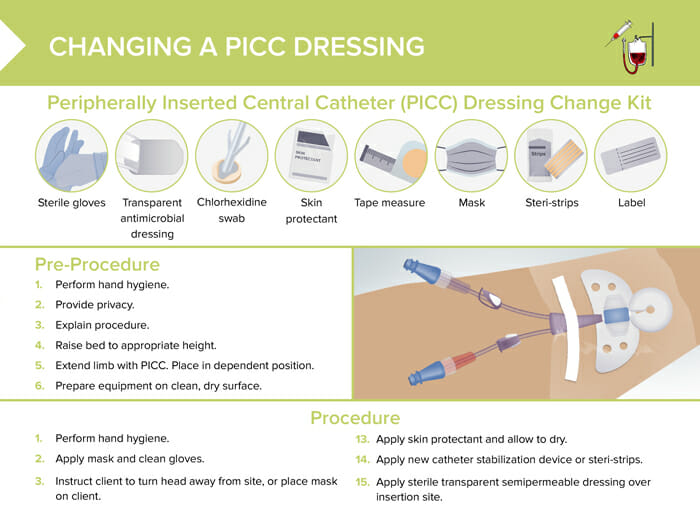Types of PICC line dressings
A PICC line is a long, thin tube that is inserted through a vein in the arm and passed through to the larger veins near the heart. It is important to change the dressing regularly to prevent infection and ensure the line remains functional.
PICC line dressings have the function of covering and protecting the PICC insertion site, preventing infection and maintaining the line’s position.
Transparent film dressings are often used for visible inspection of the insertion site, allowing for a barrier to moisture but still being breathable. Some protocols may use sterile gauze and medical tape (e.g., when the client has an allergy to transparent dressing materials). Some types of dressings contain antiseptics to actively counteract microbial growth at the insertion site, such as chlorhexidine gluconate dressings. Hydrocolloid or foam dressings may be used if there is increased drainage or the client has fragile skin.
PICC line dressing change kit: supplies needed
To change a PICC line dressing, gather the following supplies:
- Sterile gloves
- Transparent antimicrobial dressing
- Chlorhexidine swab
- Skin protectant
- Tape measure
- Mask
- Steri-strips
- Label
How to change a PICC line dressing
Before changing a PICC line dressing, check the client’s skin integrity and consider any allergies the client may have against dressing materials. Monitor the insertion site regularly for signs of infection.
Pre-procedure: preparing a dressing change
- Perform hand hygiene.
- Provide privacy.
- Explain procedure.
- Raise bed to appropriate height.
- Extend limb with PICC. Place in dependent position.
- Prepare equipment on clean, dry surface.
PICC dressing change steps
- Perform hand hygiene (done during pre-procedure).
- Apply a mask and clean gloves.
- Instruct client to turn head away from site, or place mask on client.
- Remove old dressing and discard.
- Remove stabilization device or steri-strips, being careful not to dislodge catheter.
- Inspect catheter, site, and surrounding skin.
- Measure limb circumference above insertion site and compare to baseline.
- Measure external PICC length and compare to baseline.
- Remove and discard gloves. Perform hand hygiene.
- Open dressing change kit.
- Apply sterile gloves.
- Cleanse site and tubing with chlorhexidine and allow to dry.
- Apply skin protectant and allow to dry.
- Apply new catheter stabilization device or steri-strips.
- Apply sterile transparent semipermeable dressing over insertion site.
- Remove gloves, and perform hand hygiene.
- Date, time, initial and attach label to dressing.
- Dispose of soiled supplies.
- Document procedure, measurements, and client response
PICC dressing change risks
Potential complications of PICC dressing changes include infection, bleeding, and dislodgement of the catheter. These can be prevented by following proper hand hygiene, using sterile technique, and monitoring the site for any signs of complications.
How often to change PICC line dressings
The frequency of PICC line dressing changes depends on institutional policies, the care setting, and the client’s individual needs. Generally, transparent dressings are changed every 5–7 days or sooner if there are any signs of wear or compromise. Gauze dressings are often changed every 48 hours.
PICC line dressing change documentation
Documentation of a PICC dressing change should include the following and always according to institutional guidelines:
- Client identification
- Date and time of procedure
- Appearance of insertion site (redness, swelling, infection, etc.)
- Type of dressing used
- Catheter condition (integrity of line, any clots noted)
- Documentation of the steps performed
- Client involvement: education given, client tolerance of and response to the procedure
- Complications, concerns, and healthcare provider communications
- Planned follow-ups or planned next dressing changes
- Signature

